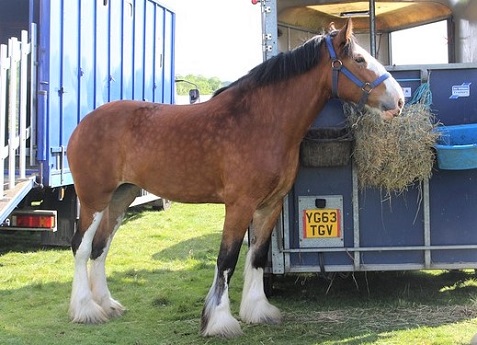Shires are a rare British draft horse breed known for their strength and beauty. There are many factors that contribute to the price of a Shire horse, including breeding, training and age.
A Shire horse will cost on average between $5,000 to $12,000. However, some top stallions and show horses will cost $20,000 and up. Factors such as age, bloodlines, training, conformation, show record, and color can play a role in the price.
According to the Livestock Conservancy, Shires are a threatened breed. This means that there are fewer than 1,000 annual registrations in America, with an estimated global population of less than 5,000. Since Shires are rare, it is often hard to find them for sale.
Factors That Affect the Price of a Shire Horse
When finding out how much a Shire horse costs, these are some of the main factors that will determine the price:
Bloodlines
As with any breed, bloodlines will play a role in the cost of a Shire. A horse with top bloodlines will sell for more money.
People will seek after Shire’s with champion pedigrees, in hopes that the horse will find the same success as its parents. Shire’s are carefully bred to have a strong, tall build, which is highly sought after in the breed. People will carefully research bloodlines to ensure they are breeding for a quality horse.
Training
Though Shires were traditionally used to work fields and pull carriages, they are now gaining popularity as riding horses. Considered one of the strongest horse breeds, Shires still compete in pulling contests, driving and riding, with some horses still being used for farm work and even logging.
Training a horse can be expensive, as a professional will have to work a horse several times a week to keep them in shape. Show horses are generally kept in training to keep up with the demands of competing. This means a horse that is in show training will cost more than one that only gets ridden or driven a few times a month.
Show Records
Though Shires are a rare horse breed, they can still be found in the show ring. Their tall, muscular builds and elegant feathering on their legs make them stand out in a crowd.
Shires show in different divisions such as in-hand, hunter pleasure, carriage driving and pulling competitions. They have steady temperaments and are hard workers, allowing them to shine at whatever they do. A Shire horse with a winning show record can easily sell for $15,000 or more.
Color
Shires are typically black, bay, brown and gray in color. Though chestnut is allowed in the American registry, it is not an acceptable color in the UK.
Any excessive white markings or roan coloring is undesirable within the breed. Horses that fall within the color stands will often sell for more than those with undesirable markings and colors.
Age and Conformation
Shires are best known for their tall, muscular builds and long, silky feathering. They should have a short, strong back, arched neck, wide chest and a long lean head, often exhibiting a slightly Roman nose. Horses that meet all these characteristics will typically sell at a higher price.
In addition to conformation, age will play a role in the price. The prime age of a Shire is between 5-14 years old. At these ages, horses are their most fit for riding and driving. Horses in their late teens or early 20s will typically sell for significantly less.

Monthly Costs of a Shire Horse
It is important to take into consideration the monthly cost to own a Shire horse before buying one. Boarding often costs anywhere between $150-$1,000 a month, depending on if your horse lives in a stall or pasture.
The cost of board typically includes food, bedding and basic care, though some places to charge more for draft horses due to their size. Your horse will need its hooves done by a farrier every 6-8 weeks, which typically costs around $75 and up for draft horses. Annual veterinary cost will generally be $200-$400, with dentistry costing $80-$250 every six months to a year.
Since Shire horses have long feathers on their legs, they need to be regularly washed and maintained. Owners should invest in quality shampoo and conditioner to upkeep their horse’s feathers.
Considered one of the largest horse breeds, they often need larger tack than the average horse. Draft-sized tack is often more expensive, as it is specialized to fit large horses.
Other Options Besides Buying
Buying a horse isn’t a realistic option for everyone, but fortunately there are other alternatives available. Leasing and joint ownership are the main two options to buying your own horse.
In some cases, owners may offer their horses for lease. This allows you to have partial or full use of a horse without spending as much money as purchasing your own. Another option is a limited liability company (LLC) or partnership, which splits the costs of buying and owning a Shire with other people.
Owning a Shire Horse
Whether for driving, work or even riding, Shires can make wonderful horses to own. They have beautiful large builds and friendly, docile personalities, making them great for people of all ages.
You can generally expect to pay anywhere from $5,000-$12,000 for a Shire, keeping in mind stallions and top show horses may cost more. However, it is important to remember Shires are a rare breed, so it can be hard to find one for sale. If you are looking to buy a draft horse, a Shire might be the right one for you.
Source: horseyhooves.com








